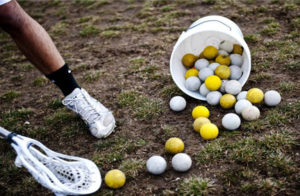Not playing multiple sports.
Playing multiple sports in high school has some huge advantages. Lets first think back to how athletes of older generations trained for their respective season. The answer is most didn’t, in the past athletes played 3 or sometimes 4 sports. It was a natural periodization model in which the athlete was exposed to many different training qualities through the different sports. For example, you got strength and power from football, vertical power and multidirectional movement from basketball, and rotational power and speed from lacrosse. Unfortunately, those days are all but gone. An example of a model year for a high school lacrosse player it would be fall (football) winter (lacrosse training) spring (lacrosse) summer (football training). This gives the athlete balance and the proper time to recover and prepare for each sport. It also allows you to get coaching and valuable life lessons from more than one coach. Which in itself could prove to be the most valuable thing.
Not taking time off after the season before club travel.
Players on competitive teams sometimes have high school games late into the school year and then head right to club travel and practice. In my opinion that this is where a lot of negative issues occur. We need to understand that the athlete’s body just finished a hard and stressful season and needs time to recover. Note I used the word recover not rest. Sitting on the couch is not recovery. If we go from one stressful season right to the next we increase the risk of injury. These weeks after the season are an opportunity to evaluate the athlete’s movement quality and address any injuries that might have occurred. This is also an opportunity give the athlete variation in their movement patterns. It is important to move away from the game for 1-2 weeks and include those different movements. This is not only beneficial for the athlete’s physiology but great for the psychology as well. That could come in the form of pick-up basketball with friends or golf with dad. After that period it’s important to begin to train for the summer club travel. This is where you will likely have the opportunity to play in front of college coaches so it is important we make a good impression. You would rather dominate two tournaments then look tired and slow at the fourth. So don’t create a schedule that includes too much travel and takes away from your summer training goals. You should be using your training during this period to peak you for these summer tournaments. Once again it is important that you seek out a qualified strength coach to assist you with this process.
Focusing on “getting big”.
You always over hear athletes talking about how “big” they want to get in the off-season. And by big, I mean hypertrophy or adding muscle size. There are many situations where there is a need for adding healthy mass to improve performance in a contact sport. But for the most part we are under the assumption that the bigger and stronger we get the better we will play next season. This is not always true. Unfortunately, I thought the same thing and from my freshman year of college to my sophmore year I went from 180lbs to 205lbs. I thought this would improve my performance on the lacrosse field with my added size and strength. But I was wrong!!! When I got on the field I had not trained for the multidirectional movements that are needed in lacrosse. I was slower and had felt like I had lost a step along with the fact that my new bench press max did not transfer to the field. I was a lot stronger but I had lost valuable mobility in the process. There is a general misconception that you have to increase muscle mass to gain strength. I could have stayed at a healthy 180 and gotten just as strong with a solid training program and most importantly a diet based on natural food. Always remember you can’t out-train a poor diet. The things our lacrosse athletes should be focused on is the training qualities that we see on the field. Identify our weak links and address them to create a healthy and balanced athlete.
Concussion Protocols/ Movement Evaluations.
Lacrosse is a contact sport and there is a chance for concussion. Don’t let a concussion hold you back from the sport that you love. Find a qualified concussion specialist and get a baseline screening. This will improve the quality of your recovery if you do get a concussion. With a baseline screen, you give your medical professional a huge advantage vs. if you did not have one. It is also important that you find a qualified individual to perform a movement screen to identify weak links in your body. If one area of the kinetic chain is disrupted it will affect the entire body. Look for an individual that has extensive experience with chain reaction biomechanics. Even if you cannot train with this individual full time it is important to get a quality screen. This way you can go back to see if your training is improving the areas your individual body needs. Remember lacrosse is a rotational dominant sport so this evaluation should include rotational components if it doesn’t you might miss something.
It’s what you do when no one is watching that counts.
How many hours do you spend alone working on your stick? Doing your specific mobility drills? Watching game film? Its the small things that will separate you from everyone else. If you want to play lacrosse at the next level your not going to do it by just showing up to practice. If you took 10min a day to hit the wall how much better would you get?
“It takes time to create excellence. If it could be done quickly, more people would do it.” – John Wooden



Leave a Reply